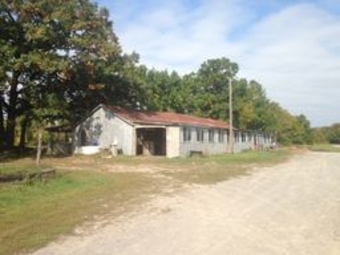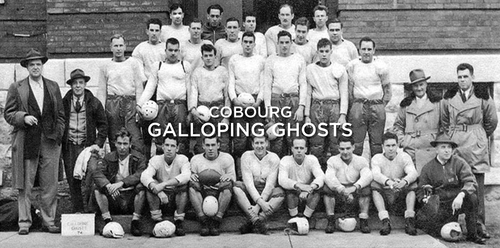
Cliff Hie had a homebred colt that showed him promise as a race horse. The colt’s name was Thor Gratton. Thor Gratton was a special breed, a harness horse, a horse that was steered by a driver in a light cart that trailed the horse, not ridden under saddle. It was the late 1940s and Cliff, a farmer and owner of Hieland Farm just north of Cobourg, had caught the bug of harness horse racing. Cliff was not unique.
Many farmers and local rural residents shared the passion for harness racing. Their common problem was they had no suitable place to train their steeds other than township roads and rough tracks through farm fields.
Harness racing formally known as Standardbred racing evolved from the informal competitions that were common among the early rural residents of southern Ontario and Quebec. Prestige and bragging rights were at stake in the friendly races that took place among horsemen in buggies and light carts on the way to town or the road home from church. As the informal competitions evolved into sanctioned race meets, standards were established for the type of horse that qualified to race as a harness horse.
The standards were very strict and the horses that met the standards became known as Standardbreds and by those standards were differentiated as a breed from Thoroughbreds, the type of race horse that was ridden. One of the standards that had to be met to qualify as a Standardbred was gait. The Standardbred horse had to stay on gait; either trotting (opposite legs forward at the same time) or pacing (legs on the same side forward together). Galloping like a Thoroughbred was not acceptable.
Cliff Hie knew that for Thor Gratton to be competitive on the tracks at the local fairs the colt needed to be trained on an oval track. The solution was to build a proper training facility and in 1950 Hie along with Basil Samons, also from Cobourg and Jack Gordon of Cold Springs put up $300.00 to purchase 28 acres from Clarence Giddings. The land was located west of Baltimore and north of Dale Road at the corner of the present-day Racetrack and Ferguson Roads.
The dry sandy soil of the acreage was not particularly suited for farming but as the land was flat and treeless it was ideal for the development of a Standardbred training track. A track was soon laid out. Topsoil from the footprint of the oval was easily removed using farm tractors and scraper blades to expose hard-packed sandy soil which was perfect footing for horses. Training then began in earnest. The three partners either drove their horses to the track or trucked them in to train at top speed over the half-mile oval.
With a track in place there was no reason not to have a race meet. A judge’s stand was built in the infield and the first formal race meet took place in the summer of 1951, a Field Day as it was called, at Hamilton Township Raceway. The men raced the horses and their wives and other local women prepared and sold hotdogs, drinks and home baking. Five double dashes, 10 races in total made up a card of racing. Six to eight horses competed in each mile-long race. Horses came from as far as Orono, Peterborough and Norwood.
The start of each race was controlled by a mobile starting gate provided by the Mitchell family from Brighton. The starting gate consisted of a small truck with a set of folding wings mounted on the back end of the truck box. On the backstretch, drivers would line up their steeds behind the wings of the gate spread to the width of the track.
Gradually the starting gate accelerated as it rounded the top end and on to the straightaway accelerating further as it approached the starting line. Drivers coaxed their skittish horses to nose up to the gate trying to find that sweet spot of having the horse reach maximum speed at the moment the gate reached the starting line and sped away from the phalanx of thundering hooves.
“Annnnd their off” was the call of announcer Murray Noble, ‘first off the gate is Mt Orab Boy followed closely by Hollyrood Richard as Ivan Thackeray tucks Londa’s Girl into 3rd place behind the leaders’. The race was on. The horses tore into the first turn, the tails of the driver’s silk uniforms fluttering behind them and back of that a rolling cloud of rising dust. Twice around the track to make a mile long race and hopefully a three-a-breast finish for the entertainment of the cheering fans.
Typically, a race was completed over the mile-long distance in 2:20 (2 minutes 20 seconds). A fast race went in 2:10 and the track record of 2:08 was set by Mount Orab Boy. Purse money was minimal. Sixty dollars was typically split among the top finishers of each race. Each entrant paid an entry fee and the rest of the purse money was generated from spectator admission fees of 75 cents, hot dog, sandwich and coffee sales.
Costs of staging the Field Days were minimal as the food and coffee were donated and the announcing, track maintenance and race starting services were provided at no charge. Needless to say, no one was getting rich but the horsemen received their rewards from the pleasure of participating and satisfaction of pursuing their passion. Those who did it loved it.
For the spectators at the time when television was in its infancy, the Field Days provided a local source of drama, excitement and entertainment. A festive atmosphere prevailed. The races were sanctioned by the Canadian Trotting Association. Clerk of the Course Bruce Haligan submitted records of race times, order of finish and purse money won to the Association.
A highlight of the Field Days at Hamilton Township Raceway was participation in one of the race meets by renowned Standardbred driver and trainer Keith Waples from Victoria Harbour, Ontario. Waples was later named a member of both the Canadian and US Harness Racing Halls of Fame and the Canadian Sports Hall of Fame. The last field Day was held in 1960.
The real benefit of the track to the horsemen was the training facility. The coarse gravel of township roads and rough tracks over farm fields were at best poorly suited for bringing a trotting or pacing horse up to full speed. With the conditioning attained by training on a real track, many local horses were able to be competitive at fall fairs and the best of them went on to be winners at Toronto and larger centres. With the conditioning achieved by training on the Baltimore track Thor Gratton went on to reach the potential Cliff Hie recognized and won recognition as one of the best horses in Canada in 1951 when he won 34 races.
Shortly after construction of the track, a barn was built so horsemen could stable their stock at the track eliminating the efforts of trucking them in for training. Bleachers were added so racing fans could be comfortably seated to watch the race meets. Occasionally, Thoroughbreds raced at the track and in the 1960s the track intermittently hosted chuck wagon races.
As the popularity of harness racing grew in the 1960s and 70s, more barns were built and more horsemen began to use the Baltimore track as a training base. In addition to the original owners, Jack Ball, Osler Burrison, Ivan Thackeray, Everett Adams, Len Calacott, Gord Sherwin, the Reid brothers, Ken Johns, Horace Davey, Rick Clapperton, Gail Finney, Don Budd and many others kept stables at the track or nearby farms. Tom Gratton set up a blacksmith shop on the grounds to service the need for keeping the horses properly fitted with racing shoes.
Veterinarians visited on a regular basis to doctor the horse’s aches, pains and injuries. It was during the 1970s when one visiting horseman who noted the proliferation of grasshoppers in the dry grasses surrounding the track nick-named the facility Grasshopper Flats, an affectionate name by which the track is still known today.
Grasshopper Flats was used as a training ground to prep horses for fall fairs at Colborne, Roseneath, Warkworth, Port Hope and Campbellford as well as weekly race meets at Orono, Belleville, Kingston and the new track at Kawartha Downs in Peterborough. Several horses trained at the track went on to the big leagues at Greenwood, Mohawk and Garden City Raceways where there was stiffer completion but larger purse money.
Prominent horses trained at the track during this period were Johnny Dale owned and trained by Jack Ball who was the winningest Standardbred horse of the year in 1961, Superior Richard owned by Cliff Hie, trained and driven by son Carman who frequently beat the top class of horses at the big tracks and owned the track record at Garden City Raceway for a period of time, Homestead Dan a trotter owned by the Burrison family of Harwood, trained and driven by Jack Gordon who set the Canadian record for 3 year old trotters in 1958 and competed with the best at the major tracks in Ontario, Quebec and the United States, and Sal Harbour trained by Roger Hie and driven by brother Carman who garnered the honour of 3 year old Filly of the Year in 1989 and won purse money of over $400,000.00.
Some local horsemen used the facility to train their horses during the spring and then would move their entire racing stable to the major tracks for the summer race meets. Although it never seemed like work, the track supplied employment and business opportunities for many men and women and a career starting point for others.
Jack Gordon’s son Garth, Basil Samons’ nephew Murray and Cliff Hie’s sons Carman, Roger and Doug all went on to have professional careers as Standardbred trainers and drivers. For others, Grasshopper Flats was simply a place of pleasure and relaxation as they chased their dreams of developing the next great horse.
In recent years the popularity of Standardbred racing has declined. Nevertheless, Grasshopper Flats is yet being used as a Standardbred training centre. A few trainers still base their stables at the track and good horses are still being developed there.
Ideal Jet owned and trained by Craig Barss competes regularly with the best class of horses at Woodbine Raceway in Toronto, has won purse money of over $400,000.00 and owns a race record of 1:49.2, a far cry from the times of 2:20 that won many races at the Grasshopper Flat’s Field Days.
Ownership of the Grasshopper Flats passed from the original three partners to Cliff Hie and now is owned by Cliff’s sons, Carman and Doug and grandchildren Scott and Susy. It was Cliff Hie’s wish that as long as the track was being used to train Standardbred horses that it not be sold. The love of the sport by horsemen and women no doubt means that horses will continue to train at Grasshopper Flats for the foreseeable future.
By Jay Sherwin
Updated August 2020


